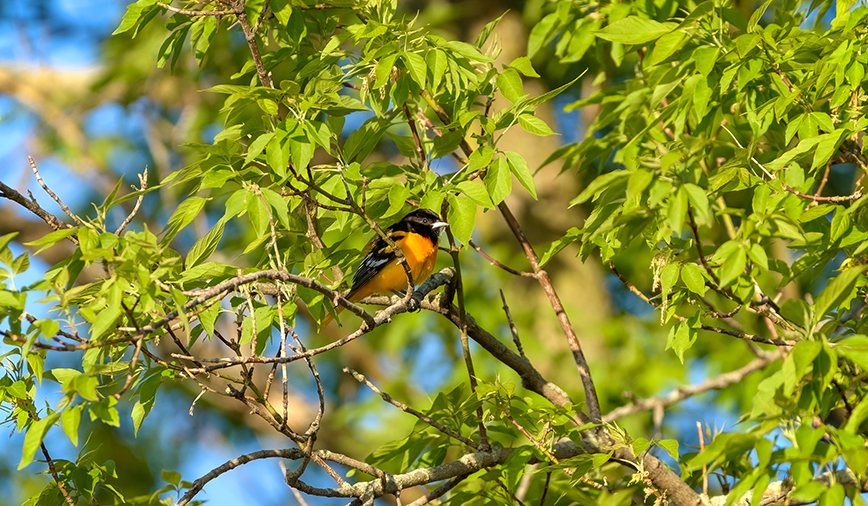Pam’s Perspective
From the…
Pam Otto is the Manager of Natural Programs and Interpretive Services for the St. Charles Park District
June 8, 2012
I remember the first time I ever saw a Baltimore oriole.
I was in the backyard of my grandmother’s house in downstate Atterberry, IL, (which, not so coincidentally, is my mother’s maiden name) and noticed what looked like baseball missing its cover, hanging in her tree.
Having recently discovered what the inside of a baseball looks like, thanks to an overzealous Labrador retriever puppy (R.I.P. Polly), all I could think of was, “What the heck was Grandma doing with a baseball, and how in the world did she get it stuck up in that tree?”
When I finally got around to asking her my questions, Grandma explained tenderly, as only grandmas can, that I wasn’t really looking at a beat-up baseball in a tree, but rather the nest of a bird she described as the “most beautiful bird in the yard”—the Baltimore oriole. She also said that if I were to sit quietly enough, for long enough, I just might be able to see the handsome bird with the bold orange and black markings, or his lovely wife, whose own yellowish-orange and brownish markings were striking in their own right.
Whether Grandma really wanted me to learn more about the bird, or whether her challenge was just a gentle way to get me to sit down and shut up, I’ll never know. But whatever the reason, her suggestion worked. I sat quietly, at the edge of the concrete patio, and stared up at the tree. Sure, I fidgeted a little; poked at some ants; and found a few four-leaf clovers (that backyard had the most amazing patch of four-leafed Trifolium repens I’ve ever seen, before or since).
Adobe Systems
And then he appeared.
His colors were so bright, at first I thought he must be some sort of exotic import. But as I matched up his colors with the description Grandma had given me I realized that had to be him.
He didn’t head for the nest (it was August and, in retrospect, I’m thinking he and his family were probably done with their woven “baseball” home by then) but instead perched on a branch on the opposite side of “his” tree.
From there the memory gets a little faded. I don’t recall whether he stuck around; I don’t even remember whether I stuck around. What I do remember is that the 10 hours, or maybe it was 10 minutes, I’d sat still felt like an eternity.
But the fact remained that that day, in that yard, in a town where the orioles quite likely outnumbered the people, I got to see, for the very first time, a bird that fascinates me to this day.
In the intervening years I’ve learned a little bit more about the Baltimore oriole’s intriguing behaviors. The nest, for example, is woven from all manner of long-fibered materials—grass stems, strips of grapevine bark and horsehair, to name a few. (Sometimes, though, the selection also includes fishing line and landscape mesh, filaments so tough they may prove deadly. Just one more reason to pick up these items, whenever you run across them, and toss them inside a covered trash can.)
Orioles, I’ve also learned, have quite a sweet tooth. Though they also feed on insects, especially during the breeding season, they are drawn to sugary foods like berries and grapes. Looking back, it makes perfect sense that Grandma had orioles in her backyard. Along the back edge of the lawn, a few feet before a sea of corn began, Grandpa had built a long arbor that grew some of the plumpest, juiciest grapes around—a buffet the orioles surely visited regularly.
Grandma used those grapes to make jelly—a food that, though not naturally occurring, is nonetheless another oriole favorite. If you’ve got orioles in your neighborhood and would like to encourage them to visit your yard, you can try enticing them with a shallow dish of grape jelly set on an open platform feeder. Orange halves sometimes work too, as do specially designed oriole nectar feeders. But don’t just set these items out and forget them—nectar can turn bad and ants can invade if such sweetness is left unattended, and uneaten, for more than a few days.
As an alternative, you might want to take spin over to Hickory Knolls. As luck would have it, we have a pair of Baltimore orioles nesting behind our building, at the edge of the Hickory Knolls Natural Area. But be forewarned…
The location, which apparently the parent birds found to their liking, is a little less than ideal for observation. The nest is suspended from the branch of a big bur oak tree that extends over the road to the Illinois Youth Center (a.k.a. Boys’ Home) correctional facility. During shift changes (and on soccer game days, since the road also leads to park district athletic fields) the traffic can get a little hairy, so time your oriole watching carefully.
Or, you can do what I did. Plunk yourself down in the tall grass, a safe distance from the side of the road. Once you spot the nest, which is now bulging with nestlings, keep your eyes trained. You will definitely see the handsome bird with the bold orange and black markings, AND his lovely wife—if you sit quietly enough, for long enough…
Pam Otto, who did indeed sit quietly enough for long enough to get a photo of the oriole, as well as an impressive array of insect bites and an unidentified larva on her neck, is the manager of nature programs and interpretive services for the St. Charles Park District. She can be reached at 630-513-4346 or potto@stcparks.org.

